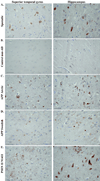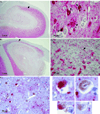Caspase-6 activation in familial alzheimer disease brains carrying amyloid precursor protein or presenilin i or presenilin II mutations
- PMID: 19915487
- PMCID: PMC3079356
- DOI: 10.1097/NEN.0b013e3181c1da10
Caspase-6 activation in familial alzheimer disease brains carrying amyloid precursor protein or presenilin i or presenilin II mutations
Erratum in
- J Neuropathol Exp Neurol. 2010 Jan;69(1):110
Abstract
We previously demonstrated the activation of caspase-6 (Casp-6) in the hippocampus and cortex in cases of mild, moderate, severe, and very severe Alzheimer disease (AD). To determine whether Casp-6 is also activated in familial AD, we performed an immunohistochemical analysis of active Casp-6 and Tau cleaved by Casp-6 in temporal cortex and hippocampal tissue sections from cases of familial AD. The cases included 5 carrying the amyloid precursor protein K670N and M671L Swedish mutation, 1 carrying the amyloid precursor protein E693G Arctic mutation, 2 each carrying the Presenilin I M146V, F105L, A431E, V261F, and Y115C mutations, and 1 with the Presenilin II N141I mutation. Active Casp-6 immunoreactivity was found in all cases. Caspase-6 immunoreactivity was observed in neuritic plaques or in some cases cotton-wool plaques, and in neuropil threads and neurofibrillary tangles. These results indicate that Casp-6 is activated in familial forms of AD, as previously observed in sporadic forms. Because sporadic and familial AD cases have similar pathological features, these results support a fundamental role of Casp-6 in the pathophysiology of both familial and sporadic AD.
Figures






References
-
- Creagh EM, Conroy H, Martin SJ. Caspase-activation pathways in apoptosis and immunity. Immunol Rev. 2003;193:10–21. - PubMed
-
- Gervais F, Xu D, Robertson G, et al. Involvement of caspases in proteolytic cleavage of Alzheimer's ß-amyloid precursor protein and amyloidogenic ß-peptide formation. Cell. 1999;97:395–406. - PubMed
-
- LeBlanc AC, Liu H, Goodyer C, et al. Caspase-6 role in apoptosis of human neurons, amyloidogenesis and Alzheimer's disease. J Biol Chem. 1999;274:23426–23436. - PubMed
-
- Tesco G, Koh YH, Tanzi RE. Caspase activation increases beta-amyloid generation independently of caspase cleavage of the beta-amyloid precursor protein (APP) J Biol Chem. 2003;278:46074–46080. - PubMed
Publication types
MeSH terms
Substances
Grants and funding
LinkOut - more resources
Full Text Sources
Other Literature Sources
Medical

